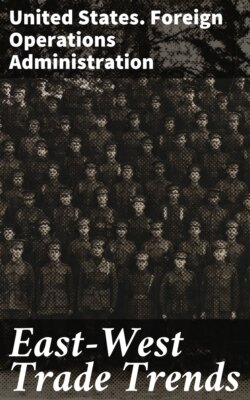Читать книгу East-West Trade Trends - United States. Foreign Operations Administration - Страница 15
Mikoyan Advertises the Program
ОглавлениеAnastas I. Mikoyan, the Soviet Minister of Domestic Trade, then made a speech October 17 before the All-Union Conference of Trade Workers.
Mikoyan, as the man in charge of large segments of the consumer goods program, enthusiastically described the program as “gigantic”. In the manner of Malenkov and Khrushchev, he also enthusiastically flayed an astonishing number of deficiencies in the production, packaging, distribution, and marketing of consumer goods. He even condemned dull advertising slogans and inconsiderate retail clerks, and said there were some things about capitalist business methods that were worthy of emulating.
He stated, too, that not only the Ministry of Consumer Goods Industry but other ministries—including aircraft and defense—were getting assignments to produce such things as refrigerators, washing machines, metal beds, bicycles, and radio and television sets. Actually, small quantities of durable consumer goods have always been produced by heavy industry ministries. Mikoyan’s statement was, no doubt, intended to sound as if these ministries were being transformed, but there is no evidence that the U.S.S.R. actually planned to reduce its production of aircraft and armaments to make way for household appliances. If such evidence shows up, the free world will welcome it.
Mikoyan gave a few figures on the production of household appliances. They revealed plans for large percentage increases, but even if achieved, these increases would still leave the consumer many years behind. For example, he said the output of refrigerators would rise from 62,000 in 1953 to 330,000 in 1955 (for a population of more than 200 million). This, even if achieved, would still be tiny by Western standards.
In August, Premier Malenkov had spoken cordially of the expansion of trade of the U.S.S.R. with Western countries but he had avoided connecting this with consumer goods. Now, however, the following brief passage appeared in the middle of Mikoyan’s long and rambling speech:
A few words must be said about the import of consumer goods. During recent years we have been making use of this additional source of supply for the population. Having become better off we can now allow ourselves to import such foodstuffs as rice, citrus fruits, bananas, pineapples, herrings, and such manufactured goods as high standard woolens and silk fabrics, furniture, and certain other goods supplementing our range. These goods are in demand by the population.
Although we are buying 4 billion rubles’ worth of consumer goods from abroad this year, two-thirds of this sum will be spent on goods from the People’s Democracies. In turn, we are exporting certain consumer goods of which we have a sufficiency, and are helping the People’s Democracies with certain commodities.
Mikoyan, revising his figures in December, estimated the Soviet Union’s imports of consumer goods from non-Communist countries in 1953 at 1 billion rubles. Rubles are not used in foreign trade and translation into dollar values may be misleading, but at the official (although artificial) rate, 1 billion rubles would be 250 million dollars. This is a slender figure in relation to the annual consumption needs of more than 200 million persons. Even so, the amount that was actually imported during the year did not equal the $250 million estimate.
There is, however, some connection between the new regime’s promises of more consumer goods and the recent activities of the Soviet Union in the field of East-West trade. We shall be examining those activities in the next chapter.
